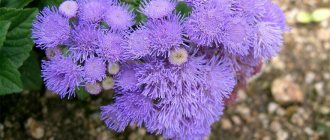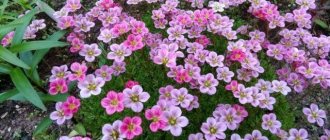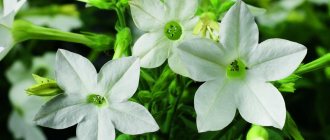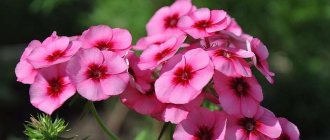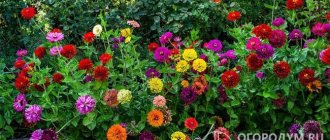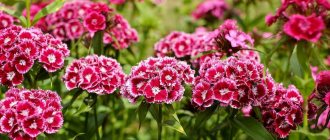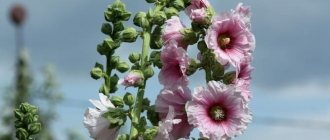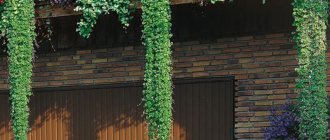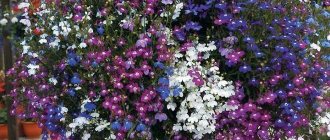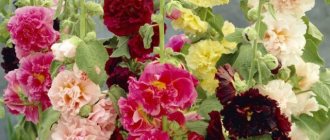The daisy is a flower that does not claim the title of star of garden design, but is quite content with the role of an extra. But, when planted in a group, blooming daisies set the tone for the entire geometry of the backyard landscape, emphasizing the boundaries of flower beds and walking areas, spreading like carpets along garden paths, creating a colorful foreground in front of high flower beds and maintaining clear boundaries of green lawns. How to plant and grow daisies, choose the right variety and make them bloom amicably and abundantly - all this requires certain knowledge and a competent approach, so we will dwell in more detail on the rules of agricultural technology for these modest, but infinitely cute flowering inhabitants of our gardens.
General description with photo
Daisies are a low herbaceous plant from the Asteraceae or Asteraceae family. They have a small compact rhizome and a leafless peduncle stem growing from a dense basal rosette. The leaves of the rosette are spatulate-elongated, with a crenate edge. Each peduncle forms only one flower head with a conical receptacle. The inflorescences of the original species are bisexual, simple, species daisies look like yellow or white multi-petaled daisies. Decorative varieties can differ greatly from each other in size, doubleness of inflorescences and, of course, their color.
According to the life cycle, they are divided into annual and perennial, however, very often gardeners practice two-year cultivation of daisies, when in the first year compact green rosettes without flowers appear from the seeds, and in the second year lush, abundant flowering occurs.
If the buds are not removed as they wither (and this is not so easy to do, given that daisies are not planted individually, but in a continuous dense carpet), then the plant will actively self-sow. But this will not make the process of planting and growing varietal daisies easier, since the most ordinary flowers will grow, having lost their valuable varietal characteristics.
Ripe fruits are a flattened achene without a tuft.
What do daisy seeds and seedlings look like?
Daisy (Bellis) is a perennial plant of the Asteraceae family, represented by one and a half dozen species. The seedlings have a short rhizome and a bare, straight stem up to 30 cm tall in adulthood. The leaves are ovate or spatulate, toothed, collected in a rosette at the base of the shoot. In spring and early summer, the plant bears single heads with yellow tubular flowers in the center and white, red or pink reeds on the edges. In June, the fruits ripen - yellow achenes up to 0.5 mm in length.
The daisy is distributed throughout the world in temperate climates.
Growing daisies from seeds
Sowing with personally collected seeds is justified only for species varieties. Ornamental varieties bred by breeders can be planted with seeds for seedlings only when they were purchased from the manufacturer. Sowing daisies can be done both as seedlings and in open ground.
Growing through seedlings
The seedling method is preferable from the point of view that in this case it will be possible to obtain flowering already in the current season. It all depends on when to plant the seeds. It is recommended to sow in February, or at least in early March, immediately using individual planting containers. The root system of daisies develops in breadth, which leads to injury to the seedlings during transplantation. Sowing is done in nutritious, structured, well-moistened soil without deepening. It is permissible to sprinkle a thin layer of sand on top. After this, the seeds need to be pressed well into the soil and the container covered with plastic wrap. Before the first seedlings appear, the dishes should be placed in a warm and well-lit place, but not in direct sunlight to avoid the formation of excessive condensation.
After germination, and this can happen after 1-2 weeks, you need to move the containers to a cool, but no less bright place. Winter daylight cannot satisfy the seedlings' need for lighting, so at first it will be necessary to supplement it with a lamp.
When to plant seedlings in open ground?
Daisies are light-loving plants that do not tolerate sudden soil frosts, especially at a young age. Therefore, seedlings are planted in open ground no earlier than the end of May or even the beginning of June.
Picking
The plant does not tolerate root injury well at a young age, so it is advisable to do without additional planting of seedlings in containers. It is better to sow the seeds with a quantitative reserve, and then carefully cut off the excess sprouts at the root with scissors. Seedlings are planted in open ground by transfer, and if grown in peat pots, together with them. The distance between neighboring bushes should be 15-20 cm, taking into account the growth of the root rosette.
Planting seeds in open ground
The earliest date for direct sowing of seeds in open ground is the end of May. It should be understood that this year it is unlikely that full flowering will be achieved, since all efforts will be directed towards the formation of the root system and leaf rosette. Seeds in open ground will need to be sprinkled with a thin layer of sand to protect them from birds and wind. Everything is covered with a film on top, which is lifted daily for ventilation. It is convenient to plant the seeds in rows. As soon as the density of seedlings can be assessed, excess plants are removed using scissors.
Do not uproot excess seedlings from the ground; this will disrupt the root system of the remaining seedlings and slow down their development.
Step-by-step instructions for planting daisy seedlings
The general expression “planting seedlings” implies not only the direct sowing of seeds into the soil. As part of proper sowing, you need to perform every step correctly: choose a suitable container, soil mixture with the most suitable characteristics, buy seeds.
The following step-by-step instructions will help you properly plant daisies for seedlings:
- Step 1: Prepare a suitable seedling container. There are no fundamental requirements in this matter; it will be quite convenient to use a regular general container of any shape (rectangular, square, round). The main thing is that it is not very high, it’s normal if it’s 7-8 cm.
- Step 2: Then you need to prepare (buy or make your own) soil mixture . The main requirements for the soil: it must be loose, light, nutritious. Daisy seedlings will feel quite good in ordinary universal soil for flower seedlings. But if you want to make the mixture yourself, you can use the following recipe: peat (2 parts), garden soil (1 part), humus (1 part), sand (1 part).
- Step 3: If you made the soil yourself, then it is recommended to disinfect : effectively steam it for 1.5 hours, or bake it in the oven (30 minutes at 90 degrees). Store-bought, as a rule, is not contagious and is rarely disinfected (however, it will be useful to spill it with a solution Fitosporin).
- Step 4: Buying seeds , it is better to give preference to products from a reliable manufacturer with a good long-term reputation. Seeds must have a normal (not expired or expiring) shelf life. There is no need to pre-sow daisy seeds; they already have good germination.
- Step 5: Immediately prepare a covering material for the selected container; it can be any tight-fitting lid, cling film, plastic bag, or even glass or shoe covers.
- Step 6: Make a good drainage system. To do this, you need to make several small holes at the bottom of the container, and then put a drainage layer (perlite, expanded clay, brick chips), a layer of 2-2.5 cm is enough. The drainage system will ensure the normal removal of excess moisture, prevent waterlogging, moisture stagnation, and therefore, it minimizes fungal diseases and root rot.
- Step 7: Fill the seedling container with soil mixture. But you don’t need to fill it to the very edges; leave a small gap between the edges and the surface of the ground.
- Step 8: Moisten the surface of the earth generously with warm and clean water; in this situation, you need to use a spray bottle. Wait until the water has absorbed a little.
- Step 9: Plant evenly over the surface of the soil.
- Step 10: Cover the container with some kind of cover: lid, film, etc.
- Step 11: Place the bowl in a bright and warm place.
Selecting a location
The place for planting daisies is selected primarily based on their decorative purpose, so you should be prepared for the fact that the composition of the soil in the selected location will have to be optimized for this crop. The question is simplified by the fact that daisies do not make great demands on the soil. But they feel best on light loam. Water should not stagnate in this place; in lowlands, you need to take care in advance of its high-quality and timely outflow.
As for lighting, daisies are unpretentious here too. They are ready to grow in an open area with sufficient moisture, and in a little passing shade. Perhaps, the only difference will be in the height of the peduncles; in the first case, they will be shorter, and the leaf rosettes will be denser.
Description of the flower and its features
For all its beauty and unusualness, the daisy is frost-resistant and unpretentious. The plant is grown as a biennial because it begins to bloom after a year. The first season is spent on the formation of a leaf rosette. But the next year, starting in April, the daisy blooms. The flowering period is extended, so you can admire their splendor until autumn.
Young daisy seedlings grown without soil. Photo used as illustration. Source: Yandex.Images
The root system of daisies is very delicate, fibrous type. The leaves are spade-shaped, pressed to the surface of the ground and collected in a rosette. They are colored rich green and have jagged edges. The stems are devoid of leaves. Their height ranges from 0.1 to 0.3 meters. The inflorescences are colored differently: from white to bright red. The core of the flowers is colored yellow. The diameter is 10-80 millimeters, in different varieties.
There are the following methods for growing daisies:
- from seed material - from January to June;
- propagation by cuttings - in May-June;
- dividing the bush (March, August).
The last two methods are great for rare varieties. In addition, dividing the bush makes it possible to prevent degeneration. Daisies are widely used in landscaping and for decorating balconies and terraces. Fans add flowers to tea.
Most common types
Today there are 80 varieties of these flowers. There are 2 groups of plants:
- Perennial.
- Annuals. This variety is often found growing wild. Reproduction is exclusively through seeds.
Beautiful mini flowerbed.
Photo used as illustration. Source: Yandex.Pictures In addition, varieties are classified according to the following criteria:
- flowering period (early and late flowering);
- diameter of buds (miniature - 10-40 millimeters, medium-sized 40-60 millimeters, large - over 60 millimeters);
- flower shape - pink, tuberose, spherical or pompom;
- flower color (white, shades of pink and red). Plants are also divided according to the type of flower color (plain, striped, speckled, with different colors of the upper and lower parts of the petal);
- terryness. There are regular, semi-double and double varieties;
- bush height (from 0.1 to 0.3 meters).
Popular varieties
- Snowball. Early variety. The flowers are snow-white, double. The number of inflorescences per 1 bush is 30 pieces. The flower size is 40-50 millimeters.
- Rosa gigantea lives up to its name. The flowers are large, double, pinkish in color. Blooms in May-June.
- Robella. The plant has large flowers, painted in all shades of pink. It grows up to 150 millimeters. The flower size is 50-60 millimeters.
- Red giant. A variety with large double red flowers.
- Pompons (pomponettes) are small flowers. The average number of inflorescences per bush is 40 pieces, the flowers are small (10-25 millimeters in diameter). The petals are feather-shaped, light pink or snow-white. The flowering period lasts 4 months (April-July).
- Rob Roy. The plant is distinguished by small (10-20 millimeters) numerous flowers, painted in different shades of pink and red.
- Etna. Extraordinarily beautiful daisies with needle-thin petals. The size of 1 flower is about 50 millimeters. There are 25 fiery inflorescences on the bush.
- Early variety Daisy. The flowers are 20-30 millimeters, simple, colored in different shades of pink.
- Snowball. The flowers are lush, large, snow-white, and look very beautiful. The bush is formed by 20 inflorescences. Flowering period May-June.
- Habanera. A hybrid plant with large (60 mm) double flowers, colored pink, red or snow-white. The petals are elegantly elongated, arranged in many rows.
Caring for Daisies
It’s not difficult to grow these flowers, but you won’t be able to forget about them for a long time. The flowerbed must be weeded regularly, watered in a timely manner and fed occasionally. You need to be careful with loosening the soil; shallow roots are easily damaged. For the same reason, you cannot delay watering, otherwise the top layer of soil will dry out and the daisies will suffer. With a lack of water, the inflorescences begin to shrink, and decorative terry varieties lose their doubleness. A layer of mulch will help partially solve this problem; the soil will release less moisture and dry out more slowly in the heat.
Mulching provides another advantage - mulch covers protruding roots, which the crop has a natural tendency to do.
Feeding
Daisies are among the plants for which feeding is the most important care item. With unobtrusive “service”, their appearance will not differ much from their wild counterparts growing in nature (in Russia - Crimea, Caucasus). If you provide them with a high level of agricultural background, they will be able to fully reveal their decorative potential. In early spring, when planting daisies or on an existing flowerbed, add a balanced mineral composition for flowering open-ground crops. After waiting for the start of budding, you need to re-feed with a composition with a reduced percentage of nitrogen inclusion or with its complete absence.
Removing faded buds can not only prolong flowering, but also cause a second wave. To do this, you can walk through a flower bed with daisies with a lawnmower, cutting off all the flower stalks at the end of flowering. Very soon there will be a new flowering, and it will continue until frost.
What kind of care does the culture require?
To improve flowering and its duration, it is worth carefully studying the care of decorative daisies. This is how fertilizing is carried out from the moment of planting.
The top dressing becomes a covering material, which turns into a mulching agent. You also need to water it correctly. After all, excess liquid is always harmful.
Watering
The daisy loves water, but overwatering harms the root system. Therefore, it is recommended to water the plant daily, but according to the principle “it is better to underwater than to overwater.” During drought, if there is no watering, the flower dries out. Due to this, the inflorescences become smaller and lose their brightness. They gradually die off.
To retain moisture, it is worth making a drainage layer. With its help, the roots are nourished better and provided with oxygen.
Top dressing
Delicate daisies and at the same time strong do not always require fertilizer mixtures. It can kill them if the dosage is overdone.
The following combined substances are suitable for the flower: Nitrophoska + Agricola, 2 tbsp. l. diluted in 10 liters of water. During the growing season, it is enough to carry out 3 procedures.
Weed removal
Daisies grow in any soil and get along well with other plants. But weeds can clog the plant and prevent it from fully developing.
Weeds should not be allowed to grow near flowers. Therefore, regular cleaning will help maintain the decor of the garden. The grass is pulled out carefully so as not to catch seedlings or an adult plant.
Vegetative propagation methods
You can plant daisies not only by the generative method (seeds), but also by cuttings and dividing the bush. This primarily applies to varietal varieties in order to preserve their visual attractiveness.
Cuttings
The best time for cutting is the last week of August or the first of September (dates may vary depending on the weather). To do this, use a sharp knife or garden pruning shears; you need to cut off the leafy side stems. They are planted immediately on a training bed with a loose nutrient substrate. You can place them in a container with water. After just a couple of weeks, the green cuttings should produce new roots. It is better to plant them in a permanent place immediately after this. Next year they will produce full blooms.
Dividing the bush
It is worth knowing that after dividing the bush, the plant does not look as neat, lush and beautiful as one grown from purchased high-quality seeds. But you will have to resort to it from time to time for reasons that will be described below. The timing is the same as for cutting cuttings, but spring division is also acceptable. An adult, full-fledged bush is divided into 4-6 parts. First, all flower stalks and leaves without petioles are pinched off. The roots of the dug out bush are shortened to 5-8 cm. This will make rooting easier.
Divisions of adult daisies easily take root even with virtually no roots at all, producing new ones from the base of the petioles, so there is no need to try to preserve their entire root system.
Reproduction of daisies by dividing the bush
The bush is divided after 2 years in order to rejuvenate the plant. The procedure is carried out as follows:
- Divide before or after flowering.
- Carefully dig up the bush and divide the root system according to the number of stems.
- Cut off leaves and dry (withered) buds.
- Trim root shoots.
Reproduction of daisies
Plant new bushes in prepared soil. The process is not too long and provides a faster reproduction option.
What you need to plant daisies
Planting is done simply and efficiently if everything is prepared for this procedure:
- Choose a good place to plant.
- Prepare the substrate.
- Treat the soil.
Next, you need to organize proper care for the sprouts.
Choosing the optimal location
Growing daisies is easy if you choose the right location in the first place. The culture prefers open areas where the bush will be illuminated by direct sunlight. But aggressive exposure can lead to sunburn, so you need to plant a taller type of plant nearby.
Selection of location and soil
Collecting seeds
Daisy seeds do not give away all at once, but as they ripen during a long flowering period, so if you want to collect all the seed material, you need to do this in stages every 5-7 days. It is necessary to carefully cut off the already wilted but not yet scattered seeds of the inflorescence, shake them out onto paper and lay them out on it to dry. For storage, paper envelopes or bags are also used, which are left in a dry and dark place for the winter.
Before harvesting, do not water the daisies; jets of water can easily wash away the ripe seeds.
Care and cultivation at home
During winter planting, seedlings are grown in a greenhouse. Planting in open soil occurs in May. It is advisable to choose a well-lit area for planting. Places where water stagnates are absolutely not suitable for daisies. The planting area needs to be level or have a slight slope.
Daisies blooming. Photo used as illustration. Source: Yandex.Images
The optimal soil reaction is 5.5-6.2. The best type of soil is loam. The soil is first fertilized with organic matter (humus, compost). Ready seedlings are planted in May-June, when there are no longer spring frosts.
Daisies are unpretentious. It is important to water them regularly, but not too much. If the summer is dry, the number of waterings per week reaches three. The soil needs to be loosened or mulched. This doesn't give weeds a chance. Care must be taken when loosening. The root system of flowers is very delicate, and even with minor damage the flower dies.
Transfer
This point of agricultural technology applies only to perennial varieties. The need for their periodic transplantation is dictated by the tendency of the culture to degenerate. At first, the planting pleases with the beauty of large double flowers, but after a few years in the same place there is no trace of its former decorativeness. As soon as the clump begins to grow, the flowers become smaller and their double quality disappears. And, if other flowering crops require rejuvenating transplantation no earlier than after 5-6 years, then daisies need this much more often. If it is not possible to replant and divide the bush, then you should at least remove the excess bushes. This is quite a troublesome, but necessary care item.
Daisies in landscape design
To decorate a garden with a plant, you need to choose a suitable place for it in the landscape design:
- Daisies look original against a green lawn.
- They go well with hyacinths, tulips, and daffodils.
- Harmonizes with coniferous trees.
Daisies in landscape design
To visually make the house bright, it is worth planting huge flower beds with bushes of different colors near the facade.
Disease and pest control
Daisies are healthy and hardy plants, but under unfavorable circumstances they can be affected by pests or diseases.
- Rodents, in particular mice, cause the most trouble for flowers. They damage the root system of daisies and the flowers die. To combat rodents, poisoned baits are used.
- Acaricides, karbofos or a solution of ordinary laundry soap help get rid of ticks.
- To destroy thrips, use Iskra or Aktara. Among folk remedies, a decoction of celandine is used.
- Single infestations by caterpillars or slugs are eliminated by manual collection of pests. For large affected areas, insecticides such as Bicol or Lepidocide are used.
- Prevention of gray and brown rot is carried out with Cupritox or copper chloride.
- A solution of copper sulfate or colloidal sulfur helps eliminate powdery mildew.
- Optimal disease prevention is the simplest way to protect plants. Avoiding thickening of the crop and overgrowing with weeds; timely watering, fertilizing and loosening the soil help keep daisies beautiful and healthy.
Prevention of plant diseases
The flower is rarely affected by pathogens and insect pests. To prevent possible illnesses, it is necessary to ensure air permeability of the soil, fight weeds, and eliminate excessive planting density. Healthy growth and development of flower bushes are also determined by timely watering and fertilizing the soil with nutrients.
The main threat is from small rodents that damage the rhizome. To combat them, baits or repellent devices are used. An ordinary garden pinwheel is considered an effective way to eliminate the danger of small rodents. The propeller device on the rod promotes the formation of low-frequency sound waves, which act as an alarm signal on the rodents, and they flee.
With proper care, daisies will decorate the landscape with a living carpet of endless blooms in a variety of colors.
